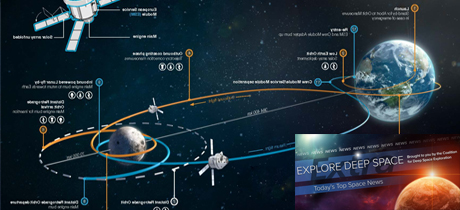In Today’s Deep Space Extra… NASA awaits a “go forward” plan after assessing whether to include astronauts on Exploration Mission-1 (EM-1), the first joint test flight of the Space Launch System and Orion. EM-1 is to send Orion around the moon and back.
Human Deep Space Exploration
NASA’s study of adding crew to EM-1 is completed, awaiting response
Spacepolicyonline.com (4/20): NASA’s assessment of whether it can add astronauts to EM-1, the first joint test flight of the Space Launch System and Orion crew exploration capsule, is complete and has been briefed to the White House as well as top agency leadership, though not yet been made public. The launch of EM-1 as an unmanned test flight of Orion around the moon and back had been planned for late 2018. In February, NASA Acting Administrator Robert Lightfoot requested that the agency study the feasibility of adding crew to EM-1, a step that had not been planned previously until EM-2, planned for 2021-23. Gale Allen, the agency’s acting chief scientist, disclosed the feasibility study’s status on Wednesday.
Space Science
President Trump to call NASA astronaut Peggy Whitson in space Monday
Space.com (4/20): On Monday, veteran NASA astronaut Peggy Whitson is to break the 534 day record for time accumulated in space over a career by a U.S. astronaut. President Trump has scheduled a congratulatory call to Whitson, the International Space Station’s current commander. Veteran NASA astronaut Jeff Williams set the current U.S. record in September 2016. Whitson launched November 17 and is due to return to Earth in early September. Her long mission will help NASA prepare for future missions of human deep space exploration.
With an eye on growing cost, NASA aims for 2025 launch of next ‘great observatory’
Spaceflightnow.com (4/19): The agency anticipates a 2025 lift-off for WFIRST, the first large NASA space observatory to follow the James Webb Space Telescope, which is being prepared to lift-off in late 2018. The $3.2 billion WFIRST’s study targets will include planets orbiting other stars and forces driving the expansion of the universe. The launch vehicle, a cost factor, has not been selected.
Asteroid misses Earth narrowly, by cosmic standards
New York Times (4/19): Asteroid 2014 JO25 sped within 1.1 million miles of the Earth early Wednesday, a safe miss, distant yet closer than any detected object of its size has come since 2004. NASA tracks the impact threat from objects 140 meters, or 460 feet, long. NASA estimates there are about 25,000 to 26,000 near Earth objects of similar size.
NASA puts $50M into creating fusion thrusters, space robots and much more
Geek Wire (4/19): A collection of NASA Small Business Innovation Research and Small Business Technology Transfer grants, announced on Wednesday, may advance the prospect for fusion rockets and remote command systems for space robots and satellites. The NASA investment in small technology companies and research institutions totals nearly $50 million.
Low Earth Orbit
Soyuz MS-04 sends two-man crew on fast-track to ISS
Spaceflight Insider.com (4/20): Russia’s Soyuz MS-04 with NASA astronaut Jack Fischer and cosmonaut Fyodor Yurchikhin lifted off for the International Space Station from the Baikonur Cosmodrome in Kazakhstan on Thursday at 3:13 a.m., EDT. With an automated docking planned for 9:23 a.m., EDT, the Space Station’s crew will grow from three to five U.S., Russian and European astronauts. Last year, Russia elected to cut the number of cosmonauts it flies aboard the Station from three to two as a cost saving measure.
Russian cosmonauts to try fermenting milk on ISS to prepare for long flights
Sputnik International (4/19): Russian cosmonauts aboard the International Space Station will attempt to ferment milk as part of an experiment to develop a nutrient that could sustain astronauts on long-running human missions of deep space exploration. “Our ability to make food in space will lead to payload weight savings,” predicted Russian cosmonaut Fyodor Yurchikhin. Yurchikhin and NASA astronaut Jack Fischer launched early Thursday from Kazakhstan for the International Space Station.
Secretive X-37B military space plane marks 700 days in orbit
Space.com (4/19): The U.S. Air Force’s secretive X-37B has passed the 700 day mark on its latest on-going Earth orbital mission. The winged reusable spacecraft launched on May 20, 2015 from Cape Canaveral Air Force Station, Florida. The mission is classified and its unclear what Orbital Test Vehicle-4 has been up to or when it will return to Earth.

